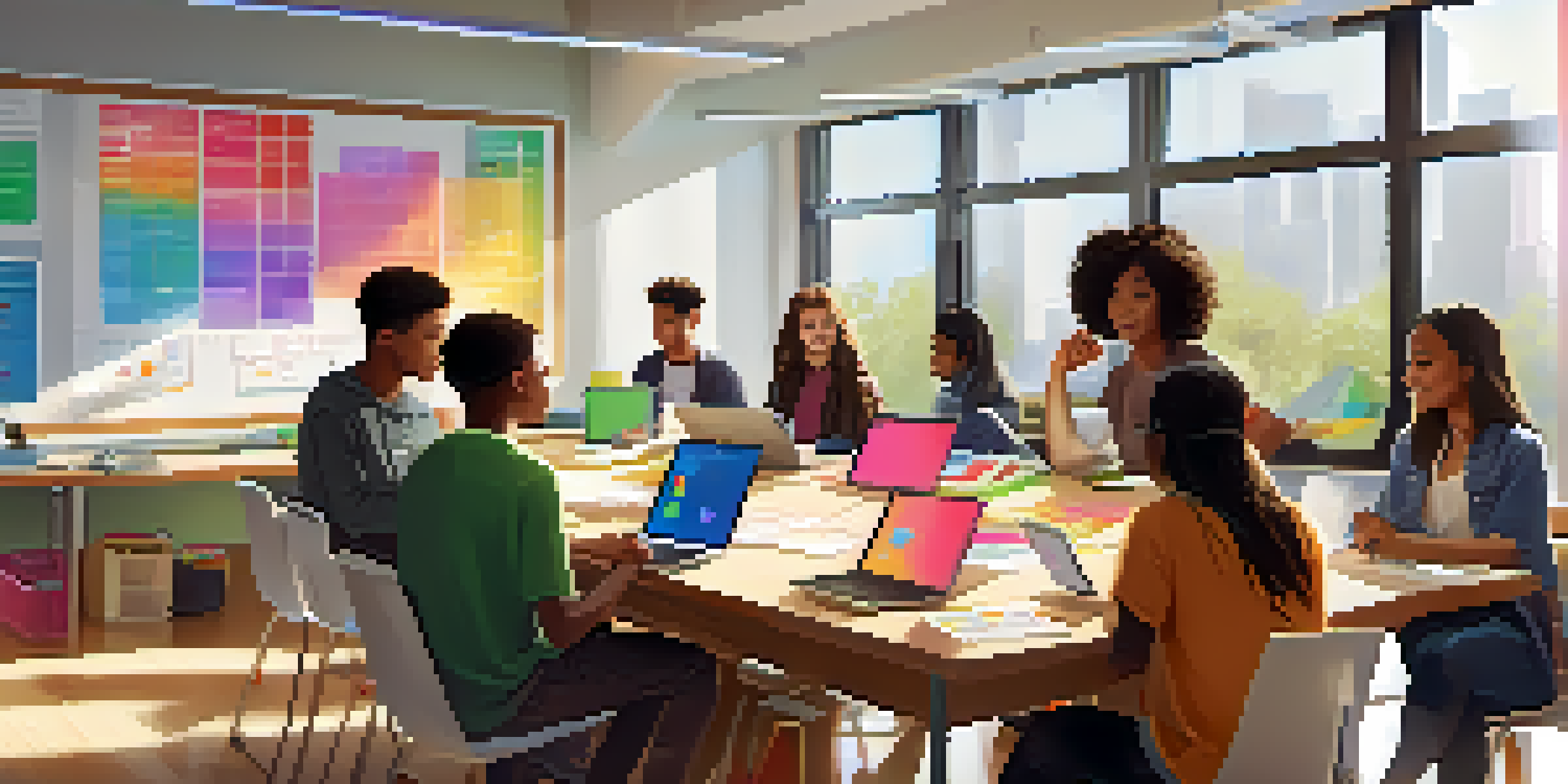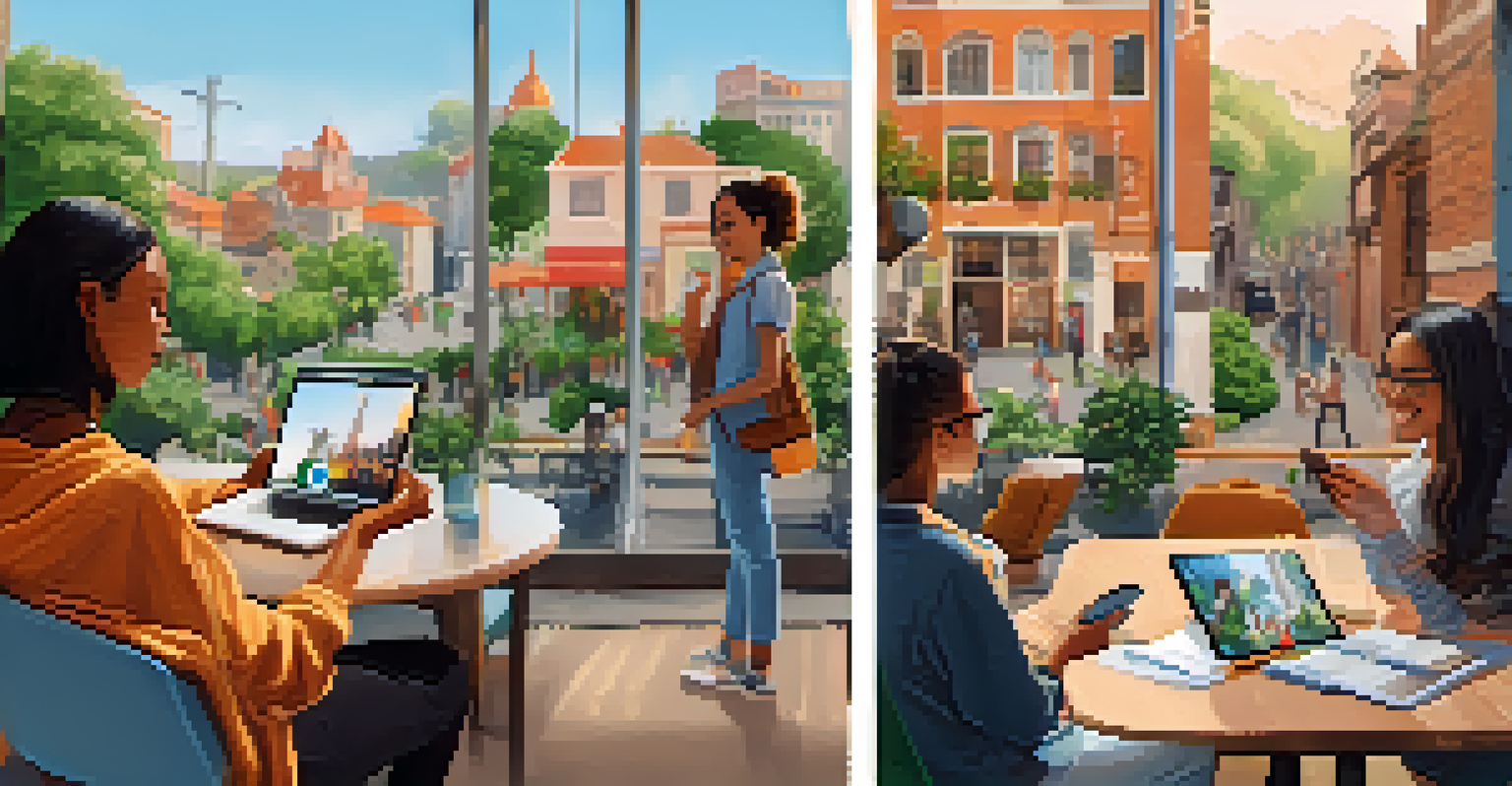Creating Collaborative Learning Opportunities with Mobile Apps

Understanding Collaborative Learning in the Digital Age
Collaborative learning emphasizes teamwork and communication, where learners work together to achieve common goals. In today's digital landscape, mobile apps play a crucial role in facilitating this approach. They allow students to connect and share ideas regardless of their physical location, making collaboration more accessible than ever.
Collaboration allows students to share their strengths and learn from one another, fostering a deeper understanding of the material.
Imagine students in different parts of the world collaborating on a project; mobile apps break down geographical barriers and enable real-time interaction. By using tools like discussion forums and shared documents, learners can contribute their unique perspectives, enriching the overall experience. This shared learning environment not only boosts understanding but also fosters a sense of community among participants.
As mobile technology continues to evolve, the potential for collaborative learning grows. Educators and students alike can harness these tools to create dynamic learning experiences that encourage creativity and critical thinking. In essence, mobile apps transform traditional learning into a vibrant, interactive process.
Choosing the Right Mobile Apps for Collaboration
With countless mobile apps available, selecting the right ones for collaborative learning can be daunting. It's essential to consider the specific needs of your learners and the goals of your project. Popular options like Google Docs and Trello offer versatile features that support teamwork, making them excellent choices for educational settings.

Think about what you want to achieve: Do you need a platform for brainstorming ideas, or is project management your priority? Your choice of app should align with these objectives. Additionally, look for user-friendly interfaces that encourage engagement, as complicated tools can often hinder collaboration rather than enhance it.
Collaborative Learning Redefined
Mobile apps facilitate real-time collaboration among learners, breaking down geographical barriers and enriching the educational experience.
Ultimately, the best apps are those that facilitate communication and streamline the learning process. By combining functionality with ease of use, educators can create an environment where students thrive together, harnessing the power of technology to enhance their collaborative efforts.
Fostering Engagement Through Interactive Features
One of the keys to successful collaborative learning is engagement, and interactive features in mobile apps can significantly enhance this aspect. Tools like polls, quizzes, and discussion boards encourage participation and make learning more dynamic. When students feel actively involved, they are more likely to take ownership of their learning.
Technology will not replace great teachers, but technology in the hands of great teachers can be transformational.
For instance, consider an app that allows students to vote on project ideas or share feedback on each other's work. This not only encourages them to express their thoughts but also fosters a culture of respect and collaboration. Such interactive elements can transform passive learning into an engaging experience that inspires creativity.
Moreover, gamification—integrating game-like elements into learning—can further boost motivation. By rewarding achievements or reaching collaborative milestones, apps can turn learning into a fun and rewarding journey, reinforcing the idea that collaboration can be enjoyable.
Creating Inclusive Learning Environments with Apps
Inclusion is a vital component of collaborative learning, and mobile apps can help create spaces where all voices are heard. Many apps offer features catering to diverse learning styles, ensuring that everyone can participate meaningfully. This inclusivity enriches discussions and enhances collective learning outcomes.
For example, apps that support audio and visual content allow students who may struggle with traditional text-based formats to contribute effectively. By embracing various methods of communication, we can foster an environment where every learner feels valued and empowered to share their insights.
Choosing the Right Tools Matters
Selecting user-friendly mobile apps tailored to specific learning needs is essential for enhancing student engagement and teamwork.
Additionally, allowing for anonymity in discussions can encourage shy or hesitant students to voice their opinions. By removing the fear of judgment, apps can promote a more open exchange of ideas, ultimately leading to deeper understanding and collaboration among peers.
Assessing Collaborative Learning Outcomes
Evaluating the success of collaborative learning initiatives is crucial for continuous improvement. Mobile apps equipped with assessment tools can help educators track progress and measure outcomes effectively. By analyzing participation levels, project completion, and group dynamics, teachers can gain valuable insights into the learning process.
For instance, apps that provide analytics on student contributions can help identify strengths and areas for improvement. This data allows educators to adjust their approaches, ensuring that all students benefit from collaborative experiences. It also provides students with feedback on their contributions, reinforcing the importance of teamwork.
Moreover, self-assessment features can encourage learners to reflect on their experiences and identify personal growth areas. This not only enhances accountability but also promotes a culture of self-directed learning, where students actively engage in their educational journeys.
Overcoming Challenges in Mobile Collaborative Learning
While mobile apps offer numerous benefits for collaborative learning, challenges can arise. Technical difficulties, such as connectivity issues or app malfunctions, can disrupt the flow of collaboration. It’s essential for educators to prepare for these scenarios, ensuring they have backup plans in place to maintain a smooth learning experience.
Another common challenge is ensuring that all participants are equally engaged. Some students may dominate discussions while others remain passive. To counter this, educators can implement strategies like assigning specific roles within groups or rotating responsibilities, encouraging every learner to contribute actively.
Future Trends in Learning Technology
Emerging technologies like AR and VR promise to further transform collaborative learning, creating immersive and engaging educational environments.
Lastly, privacy and security concerns are valid considerations when using mobile apps for educational purposes. Educators must prioritize selecting platforms that comply with data protection regulations, ensuring that students' information is safeguarded. By addressing these challenges head-on, we can create a more effective and secure collaborative learning environment.
The Future of Collaborative Learning with Mobile Technology
As technology continues to advance, the future of collaborative learning looks promising. Emerging trends like augmented reality (AR) and virtual reality (VR) are set to revolutionize how students interact in collaborative settings. Imagine a virtual classroom where learners from around the globe can meet in a shared space, working together on projects that span multiple disciplines.
Mobile apps will continue to evolve, integrating new technologies that enhance collaboration. Features such as AI-driven suggestions for group projects or personalized learning pathways can further tailor the experience to individual needs. This adaptability ensures that collaborative learning remains relevant in an ever-changing educational landscape.

Ultimately, the continued integration of mobile technology into collaborative learning experiences holds the potential to transform education. By embracing these innovations, educators can cultivate a culture of collaboration that prepares students for success in both academic and professional environments.